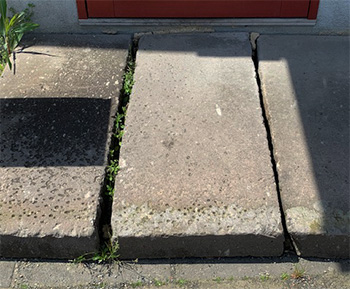

こういった建て方を「土蔵造り」と呼ぶのだそうです。
江戸時代18世紀末頃からこの篠原家はJR宇都宮駅近くのこの場所で
醬油醸造業を営み、明治期になると「肥料業」を幅広く営んでいた。
一番上の写真は2016年の現地取材時の外観写真で、
2番目は明治30年1897年の時点のもの。時代差約120年ということですが、
この建物は創建時の姿をできるだけ忠実に保存している様子がわかります。
1995年に市に寄贈されたわけですが、所有者の姿勢に誇りを見ることができる。
昨日、創建に携わった職人さんたちの心意気の墨書も紹介しましたが、
プライドを持って建てられた建築には力があると思わされる。
今日、住宅建築のメディアを作っている者として思いを感じます。
この建物の外装には大谷石と黒漆喰が使われている。
黒漆喰は漆喰に墨を混ぜ込んだ素材。一方の大谷石ですが、
この明治28年と言えば、北海道開拓で盛んに地元石材・石山軟石も切り出された。
札幌の洋造建築にたくさん利用された時期とも一致する。

写真はわが社玄関前の敷き放しの石山軟石ですが、親近感を感じる。
大谷石外観はコンクリート並みの頑丈さの印象を与えたでしょうね。
この外観、この時期最高水準の防火建築がはるか後世の米軍大空襲でも
地域の救命センターとして機能した。まさに先人の思いがいのちを守った。

で、上の写真は「屋号ヤマサ」の軒先と屋根頂部の瓦の様子です。
醬油屋さんでヤマサと言えば、と類推させられましたが、
どうもあまり直接的な関係は浮かんでこないようです。
ヤマサ醬油さんは千葉県銚子市なのでだいぶ距離も離れている。
しかし宇都宮は鬼怒川などの水運で奥州への物流拠点でもあったとされる。
関東平野は利根川水系の水運で物流ネットワークが整備されていたともされる。

図は宇都宮周辺の陸路と鬼怒川の水運・河岸の所在地。
日光街道と奥州街道の交差点に位置している。
水運主体であればもっと鬼怒川寄りに立地すべきかとも思えるが
江戸期は当然、日光は聖地とされて人流は多かったに違いない。
またこの地は政治統治の中心、宇都宮城の近接地でもあり
その関係での「御用」承りという意味合いも大きかったに違いない。
商業立地としては常識的な立地判断だったのだと思える。
で、鬼怒川水運を下っていけば、利根川水運と合流して銚子が
海運との合流点に位置するので、銚子のヤマサ醬油との関係も想像が湧く。
利根川水系の江戸川に転じていけば江戸とも繋がっている。
地域密着と外部ネットワークとの接続両方の意味で
立地というのは、やはりビジネスの要諦であることがわかりますね。
English version⬇
[Appearance and location of black plaster and Oya stone / Good Japanese house ㉝-3]
It is said that this way of building is called “Dozo-zukuri”.
Since the end of the 18th century in the Edo period, this Shinohara family has been at this place near JR Utsunomiya Station.
He ran the salty soy sauce brewing industry, and in the Meiji era he ran a wide range of “fertilizer industries”.
The top photo is the appearance photo at the time of the on-site interview in 2016.
The second is as of 1897, 1897. The time difference is about 120 years,
You can see that this building preserves its original appearance as faithfully as possible.
It was donated to the city in 1995, and we can take pride in the attitude of the owner.
Yesterday, I also introduced the spiritual ink of the craftsmen who were involved in the construction.
Architecture built with pride seems to have power.
Today, I feel like a person who makes media for residential construction.
Oya stone and black plaster are used for the exterior of this building.
Black plaster is a material in which ink is mixed with plaster. On the other hand, Oya stone
Speaking of the 28th year of the Meiji era, the local stone material, Ishiyama soft stone, was actively cut out during the development of Hokkaido.
It coincides with the time when it was used a lot for Western-style architecture in Sapporo.
The photo shows Ishiyama soft stone in front of the entrance of our company, but I feel a sense of familiarity.
The appearance of Oya stone would have impressed you with the toughness of concrete.
This appearance, the highest level of fireproof architecture at this time, even in the U.S. military air raids far later
It functioned as a local life-saving center. It just protected the thoughts of our predecessors.
The photo above shows the roof tiles on the eaves and roof of “Yamasa”.
It was analogized that Yamasa was spoken at a salty sauce shop, but
Apparently there isn’t a very direct relationship.
Yamasa Salty Sauce is located in Choshi City, Chiba Prefecture, so it is a long distance away.
However, Utsunomiya is said to have been a distribution base for Oshu by water transportation such as the Kinugawa River.
It is said that the Kanto Plain had a logistics network developed by water transportation in the Tone River system.
The figure shows the location of the land route around Utsunomiya and the water transportation and riverbanks of the Kinugawa River.
It is located at the intersection of Nikko Kaido and Oshu Kaido.
If it is mainly water transportation, it seems that it should be located closer to the Kinugawa River.
Naturally, during the Edo period, Nikko must have been a sacred place and there must have been a lot of people.
This place is also the center of political governance, close to Utsunomiya Castle.
It must have had a great meaning of accepting “use” in that relationship.
It seems that it was a common sense location judgment as a commercial location.
Then, if you go down the Kinugawa water transport, you will join the Tone river water transport and Choshi will join you.
Since it is located at the confluence with shipping, you can imagine the relationship with Choshi’s Yamasa salty sauce.
If you switch to the Edo River in the Tone River system, you will be connected to Edo.
In terms of both community-based and connection with external networks
You can see that location is the key to business.
Posted on 6月 4th, 2021 by 三木 奎吾
Filed under: 住宅マーケティング, 日本社会・文化研究







コメントを投稿
「※誹謗中傷や、悪意のある書き込み、営利目的などのコメントを防ぐために、投稿された全てのコメントは一時的に保留されますのでご了承ください。」
You must be logged in to post a comment.